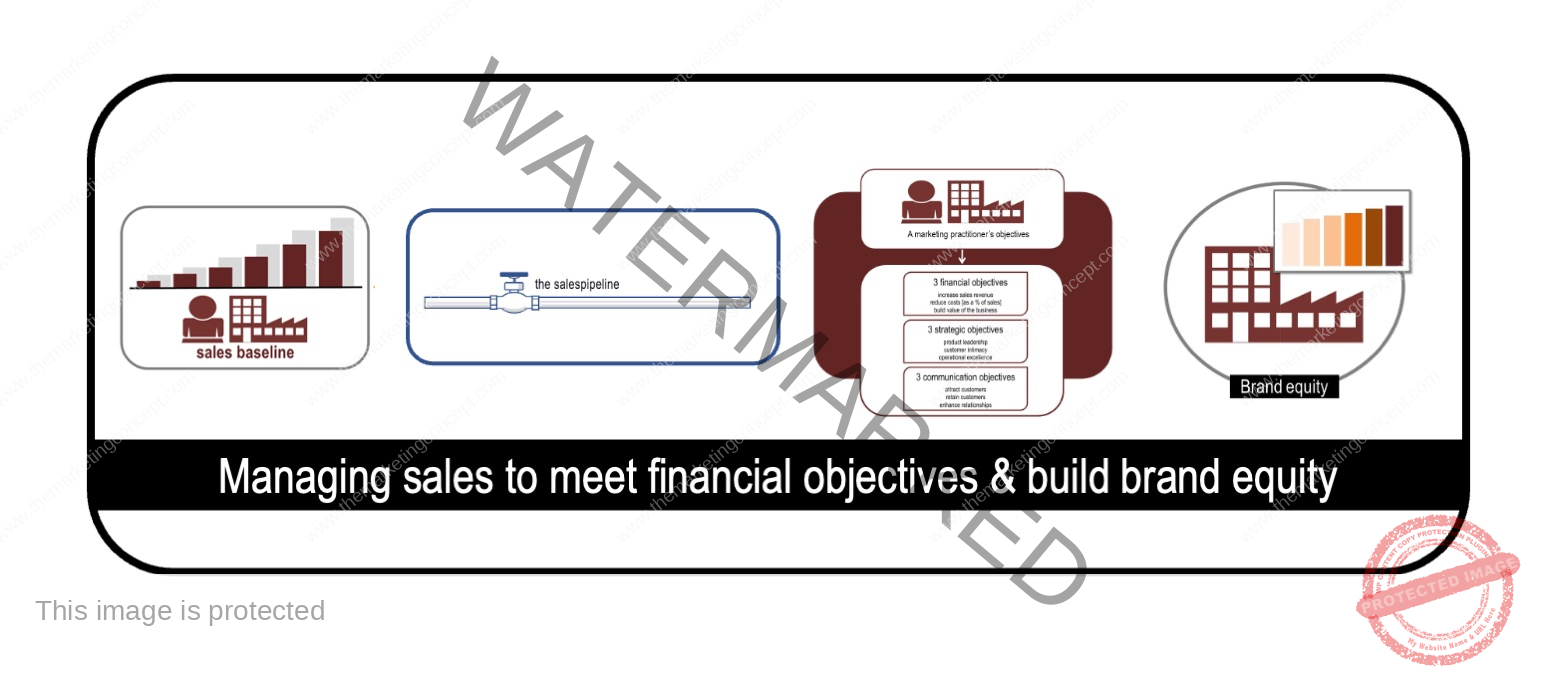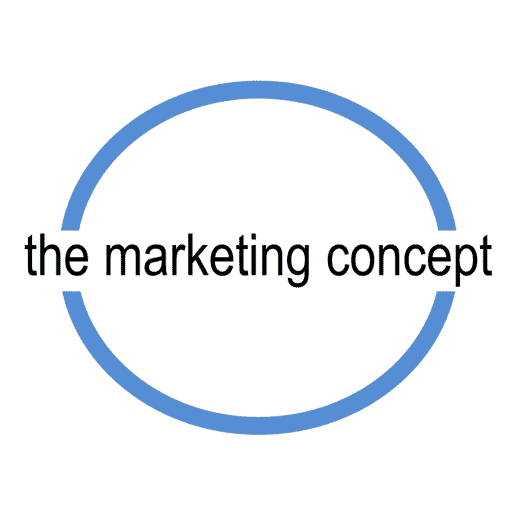
“Because the purpose of business is to create a customer, the business enterprise has two & only two basic functions: marketing & innovation. Marketing & innovation produce results; all the rest are costs. Marketing is the distinguishing, unique function of the business.”
Peter Drucker
Marketing practitioners must be able to conduct a marketing audit – design, develop, & implement a marketing plan, manage revenue ,manage different situational factors – create value & provide product leadership.
for more information download & read the free e-book
The following is a preview of what you will discover
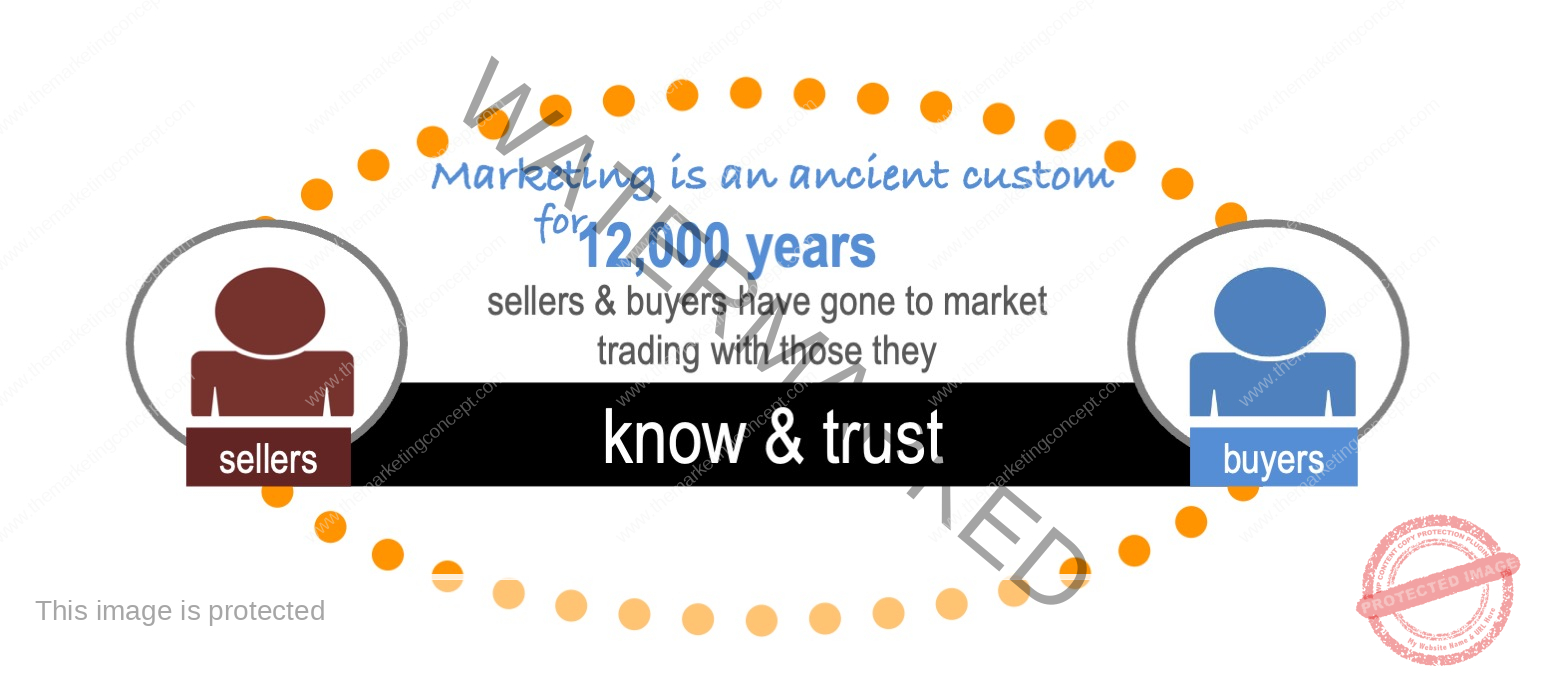
[1] History reveals the foundations of business
People trade with those they know & trust
History provides many valuable lessons and whilst many think ‘marketing’ is new – it is an ancient custom – interestingly, a customer describes a person who knows, trusts, and, therefore, makes a custom of frequenting a business.
A brief history of marketing – around 12,000 years ago, in a number of locations, nomadic hunter-gatherers evolved into sedentary peasant farmers – they built shelters and domesticated animals and plants. Whilst the hunter-gatherers were pure consumers the peasant farmers were both producers and consumers. They began to cultivate plants and animals, bred from the best, and modified their environment to maximise their effort. Peasant farmers were largely self-sufficient – they preserved and stored food; for example, cereals were cultivated and baked into bread, vegetables, fruits and dairy were pickled and/or fermented – meat and fish were salted and dried – they made their own clothing. With time peasant farmers began to trade [initially furs and hides]. Interestingly, many food products that are consumed today originated in this era – think cereals, breads, pickled vegetables. As people became sedentary, storage was necessary, pottery became one of the first human inventions. As settlements grew and livestock numbers increased, the water in wells became unsuitable for drinking – beer, wine, spirits were produced to reduce the risk of contaminated water.
In time, peasant farmers began to exchange surplus production – products. Markets needed to be within walking distance. To record transactions writing developed. To enable transactions services emerged. Others traded their skills and labour [the origins of the word ‘tradespeople’]; some specialised; for example, pottery, brewing, butchering, leather tanning, carpentry, transport. With time and availability to resources some craftspeople specialised in the production of metals [the Iron Age] – some metals were cast into tools for farming and precious metals were crafted into jewellery and coins.
In the last 3,000 years markets evolved – markets became more formal, conventions and regulations were introduced to ensure value and fairness – standard weights and measures and coins emerged to ensure ‘a fair exchange’. Products were ‘branded’ to differentiate them from copies and communicate provenance, quality, and value – products were trademarked.
The key theme is that buyers innately approach sellers they know and trust and avoid sellers they know and distrust.
The business lessons are [1] To be considered – a product/business must be known. [2] Being known and also trusted is a long-term strategic objective. [3] Businesses who fail to build customer trust are locked into a more expensive business model – more dependent on advertising, sales promotion, selling tactics, sales promotions, and discounting.
To be considered a business must be known
however, being known and trusted helps to develop a sustainable competitive advantage.
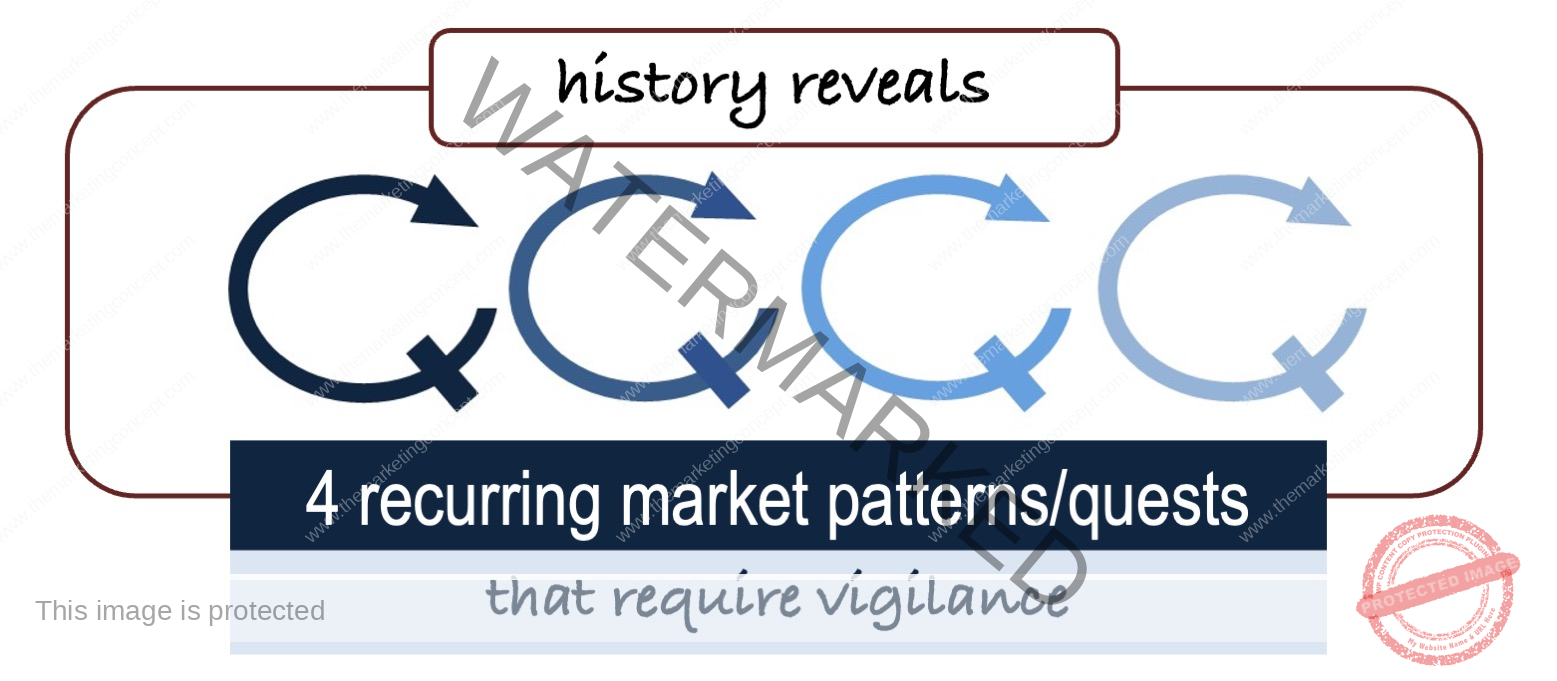
[2] The best of times – the worst of times
History reveals that customers, organisations, markets, and products are in a continuous state of evolution. To survive and succeed an organisation must manage the prevailing challenges of the times – often the challenges require a series of small-step and continuous improvements. However, there are also notable events when a market or an industry is disrupted – where the status quo is challenged, and radical change is needed. When we analyse the notable events 4 recurring patterns emerge – the challenges could also be described as ‘market quests’. Being aware of the 4 recurring patterns will assist marketing practitioners to audit the prevailing market challenges and develop strategies and tactics that best meet the needs of the customer, the organisation, the market and the product category.
The 4 market quests that marketing practitioners must manage are:
- The quest to better serve the customer
- The quest to overcome the challenges facing society
- The quest for better use [application] of existing resources/knowledge/practices
- The quest for more effective distribution of: information, products, & people
When we delve deeper, we see that consumers [therefore markets] quickly adapt and adopt when it is in their best interest – they continually search for and select best satisfying products. Through this selection process markets evolve through a series of small step improvements and big step innovations. Innovations often disrupt the status quo – innovations often provide new opportunities, however, innovations often disrupt existing industries – the best of times for some is often the worst of times for others. Marketing history highlights that products have a life-cycle. In their quest to design, develop, and deliver best satisfying products marketers should be constantly scanning the markets and adopting and applying the resources/knowledge/practices from other industries. This practice of small and big step improvements requires marketers to be vigilant and to ensure they are meeting consumer expectations.
Interestingly, many of today’s everyday products, organisations and public institutions emerged by overcoming one or more of the 4 quests. As societies evolved new business standards/benchmarks also evolved – for example: [1] creating value for their customers and employees, [2] creating value for society, [3] having a sense of purpose, and [4] developing a unique product value proposition in the marketplace.
Contrary to what is written in the media societies have, unfortunately, always had an impact on the environment – for example: access to safe drinking water has been a challenge for 12,000 years. However, often overcoming one challenge, in time, creates a new problem and a new challenge for society.
Also, societal values and expectations evolve and continue to evolve. When a society has concerns or is negatively impacted, new regulations are introduced – regulating market activities has been part of the evolution of marketing [since Greek and Roman times].
The evolution continues – we are presently experiencing several notable event and a process of natural selection is well underway. For example, in recent years we have seen retailing fracture into [1] traditional marketplace retailers and [2] digital marketspace retailers, and then, [3] omni-channel retailing where retailers are customer focused rather than channel focused. Supporters of an omni-channel marketing approach advocate that, customers no longer belong to one camp or another, instead they move freely between the marketplace and the marketspace during the buying process. When practiced well, an omni-channel approach combines customer convenience and customer experience in both the online user experience and the in-store sense of belonging. Omni-channel marketing employs evolving technologies to reintroduce customer convenience – for example, click & collect, pick-up/return-in-store, home deliveries. Marketing practitioners rarely see marketing as traditional marketing and digital marketing they simply see it as marketing – with one aim – to best satisfy the needs and wants of their customers and their organisation. Keeping in mind that customers are only loyal to value and select which retailers to approach and which to avoid.
Organisations that fail to adapt, adopt, and best satisfy – are on the path to extinction
![[3c] discover](https://www.themarketingconcept.com/wp-content/uploads/2022/05/1c-discover.jpg)
[3] The marketing concept is an axiom of business
organisations that best satisfy the needs of their customers are best placed to satisfy their own needs
the philosophy embedded within the marketing concept
It has to be mentioned that not every organisation that goes to market is practicing the philosophy embedded within the marketing concept – some are totally focussed on what they want – and see the customer as a means to an end – a resource to be mined rather than nurtured.
The marketing concept provides guidance + a philosophy. It is generally regarded that the marketing concept is an axiom [an accepted truth] of business. The marketing concept is based on organisations having a relational focus with external customers, internal customers, channel partners, and society. It is not ‘the customer is king’ nonsense.
Consider the opposite of satisfying customers – think about the organisational consequences of dissatisfaction – think about the consequence of leaving customer satisfaction to chance – think about the chaos if every staff member had their personal view of customer service – think about an organisation that does not measure metrics associated with the customers’ experience. It is worthwhile to remember, that whilst the marketing concept is customer and organisational centric – training is required to ensure that what is promised is delivered.
When an organisation has adopted the marketing concept, the planners consider their specific situational factors and then craft and document – a marketing philosophy – a set of principles, attitudes, and behaviours that provide guidance as to how an organisation goes to market – some may refer to this a mission. As every organisation faces situational factors that are somewhat unique – keep in mind – every marketing philosophy is somewhat unique – every marketing plan is somewhat unique.
A marketing philosophy is process driven – with time and with consistent internal communication a marketing culture of best satisfying and profitable4 exchange relationships4 is nurtured.
Marketing is about satisfaction2 – for the customer and the organisation
measuring satisfaction is a key task
Keep in mind what isn’t measured cannot be managed
![[3] discover](https://www.themarketingconcept.com/wp-content/uploads/2022/06/3-approaches-1.jpg)
[3] Organisations go to market with one or a mix of the 3 business market approaches
the production, the selling, and relational approaches
Different people have different views on how to go to market. There are a number of reasons for the differing views. Therefore, most organisations are an amalgam of the 3 business market approaches – however, when an organisation views customer satisfaction as the means to a competitive advantage they are practicing the marketing concept. The problem lies when an organisation has extreme views for example [1] practices a production approach that ignores the needs of others and the consequences of their actions in pursuit of a low cost/price outcome, [2] practices a selling approach that is aggressive, untruthful, and unethical in pursuit of the sale, and [3] practices a relational approach to the extent that price and sales revenue are given insufficient consideration. Often, the production approach and the selling approach view customers as a means to an end and have little regard for customer satisfaction. Practicing the marketing concept is about profit for the customer, organisation, channel partners and society and relationships that are synergistic, symbiotic, strategic, and sustainable and considers short-term and long term marketing objectives.
The production [low cost/price] approach is based on the premise that if a product meets a customer’s core/basic needs and is priced at an attractively low price – then volume and then profit can be achieved. The problems are that [a] not every organisation has a low-production cost advantage and [b] not every organisation has access to a sufficiently large market. Therefore, not every organisation can profitably achieve or maintain the lowest price – the production concept should be implemented with caution. The production concept is a popular approach for new market entrants with low-costs or low labour costs who wish to gain volume; however, it generally has a limited life as new entrants may enter the market with lower operating costs. Furthermore, as a business grows operating costs often increase require higher prices.
The selling [communication/persuasion] approach is based on the premise that organisations need to communicate their unique product value proposition to the market to create awareness, interest, desire, and action. The emphasis on selling will vary according to the prevailing situational factors and product demand. The selling approach may gain greater acceptance when an organisation no longer has a cost advantage, no longer has a compelling value proposition [based on being the lowest price], and/or when demand has dropped below production capacity. The belief is that if a product is not desired and demanded then the organisation must aggressively sell the product and overcome customer objections. When there is an over emphasis on the selling approach the aggressive nature generally results in limited customer appeal, low levels of customer loyalty, and a short-term benefit. Keep in mind, that there are unsought products with societal benefits that may require a more aggressive approach to cut through complacency.
The relational [profitable exchange relationship] approach starts with the needs of the customer and is directed towards the satisfaction of the customer and the satisfaction of the organisation. The relational approach does not imply that the organisation’s needs are secondary; it implies that customer satisfaction is the best route to achieving organisational satisfaction. At first inspection, the production and the selling approaches appear to have much in common with the relational approach; whilst there are similarities there are fundamental differences.
Employees have often been trained by previous employers
Within any organisation there is diversity – staff arrive at an organisation enculturated to the previous organisational philosophy, therefore, many organisations are an amalgam of business philosophies and effort is needed to acculturate staff to the preferred organisational philosophy and with time nurture the preferred organisational culture. Clearly, different employees will vary on their commitment to the customer, the organisation, and society.
The marketing concept is the most adopted business concept.
Regis McKenna, a strategy consultant, who created the strategic marketing plans for many of today’s most respected technology brands, stated that ‘marketing is everything and everything is marketing’. In this statement he highlights the importance of recognising that every interaction between an organisation and a consumer – communicates a message, how messages are cumulative, and how an organisation’s actions speak louder than an organisation’s words. Marketing is not something you do to a consumer but rather something you do with a marketplace.
impatient organisations are often tempted to reach for a ‘business sugar fix’ – discounting and/or overpromising
![[5c] discover](https://www.themarketingconcept.com/wp-content/uploads/2022/06/best-satisfying.jpg)
[5] Understanding customers dreams, desires, and demand
Marketing practitioners must have a thorough understanding of their customers. Understanding needs and wants and the schemas that guide behaviour is an important step. Although best satisfying needs is critical – often a consumer’s wants may be the determinant factor.
An understanding of the consumer/customer is critical – and is often referred to as the 1st Gap of management. Sellers and buyers go to market to satisfy their needs and wants. That’s right organisations also have needs and wants. Needs and wants are terms that are often used interchangeably in our daily lives; however, there are differences that influence the design, development, and delivery of marketing strategy and tactics.
For consumers – needs can be biogenic [for the body] and/or psychogenic [for the mind], satisfying a need will have benefits and they can be utilitarian [function] and/or hedonic [pleasure] benefits – most marketers think of Maslow’s extended hierarchy of needs.
Sure – for a consumer to enter the buyer decision process there must be the recognition of a need – Needs are the motivation to go to market, HOWEVER, for a product to be selected from other alternatives the consumer must want a particular product more than they want other products. The organisation that designs, develops, and delivers a unique product value proposition [UPVP] and can then clearly communicate how their product offering best satisfies the needs and wants of their customer will be better positioned to be the product of choice.
A schema is the result of an innate cognitive process where people attend, interpret, organise, and catagorise information, consider the associations and relationships and store this information in an associative network for efficient retrieval, future conversations, and decision-making. A key task for organisations is to be mindful of consumer schemas and guide consumers comfortably through the buyer decision process.
Customer knowledge is the first step
however, marketing practitioners should be able to identify, measure, & manage the 5 performance gaps*
- the knowledge gap – do you as a manager really understand your customers?
- the standards gap – have you documented & distributed the delivery specification, standards, & processes?
- the delivery gap – are you measuring to ensure documented specifications are delivered?
- the communication gap – are you promising what you can deliver?
- the total gap – are you measuring customer expectations > what is actually received/delivered > degree of satisfaction?
What is your organisation’s unique product value proposition and can it be easily communicated, understood, and delivered?
*see the e-book for more on this and references.
![[7b] discover](https://www.themarketingconcept.com/wp-content/uploads/2022/06/PeR-44.jpg)
[6] Achieving profitable exchange relationships requires a more holistic view of profits & relationships
Organisations have different market approach. in sum – the production concept is based on the premise that people will be attracted by a low-price; the selling concept is based on the premise that persuasion is needed to convince people; and the marketing concept is built on the premise that organisations that best satisfy the needs of their customers are best placed to satisfy their own needs. Implied is that satisfied customers will provide a service to organisations that they have relationships. Whilst the marketing concept is the primary or superordinate concept; profitable4 exchange relationships4should be recognised as the goal.
Let’s discus profits & relationships
profits4 – profits for the customer, organisation, channel partners, and society.
Profits – When most people think ‘profit’ they think a ‘financial profit’ for an organisation, for example – a financial profit from an exchange[s], a financial profit in a quarter/year – it infers a profit for the organisation and few think about a profit for the customer. Although attaining a financial profit for an organisation is vital, from a marketing perspective this is a limited view of profit. An organisation that is committed to building relationships should endeavour to achieve four profit outcomes – [i.e., total profits4] profits for the customer, organisation, channel partners, and society.
relationships4 also have 4 elements – relationships should be synergistic, symbiotic, strategic, & sustainable
Relationships – For thousands of years a marketing philosophy based on relationships has been the cornerstone of commerce. This philosophy goes beyond seeing the customer as the ‘demander’ in a supply and demand economy. From our contemporary [organisational] definition of marketing we can see that often an exchange is more than a one-off transaction and every exchange should work towards building profitable business relationships for the benefit of all parties – building the sales baseline [more on this later].
WARNINGS
[1] There is a tendency to regard one-off purchases as having limited opportunity to develop relationships. This is not necessarily the case – think Word OF MOUTH. Clearly, involvement with a product varies and relationships with products and suppliers will vary, not all relationships are long-term or ongoing, some relationships are short and are unlikely to be repeated – but keep in mind there can still be a type of relationship.
[2] There is a tendency to consider that relationships only exist with high involvement products and to consider frequently purchased low involvement products [e.g., fast moving consumer goods] less dependent on a relational approach. This is not necessarily the case – think about your weekly purchases and consider what you place in your shopping cart each week.
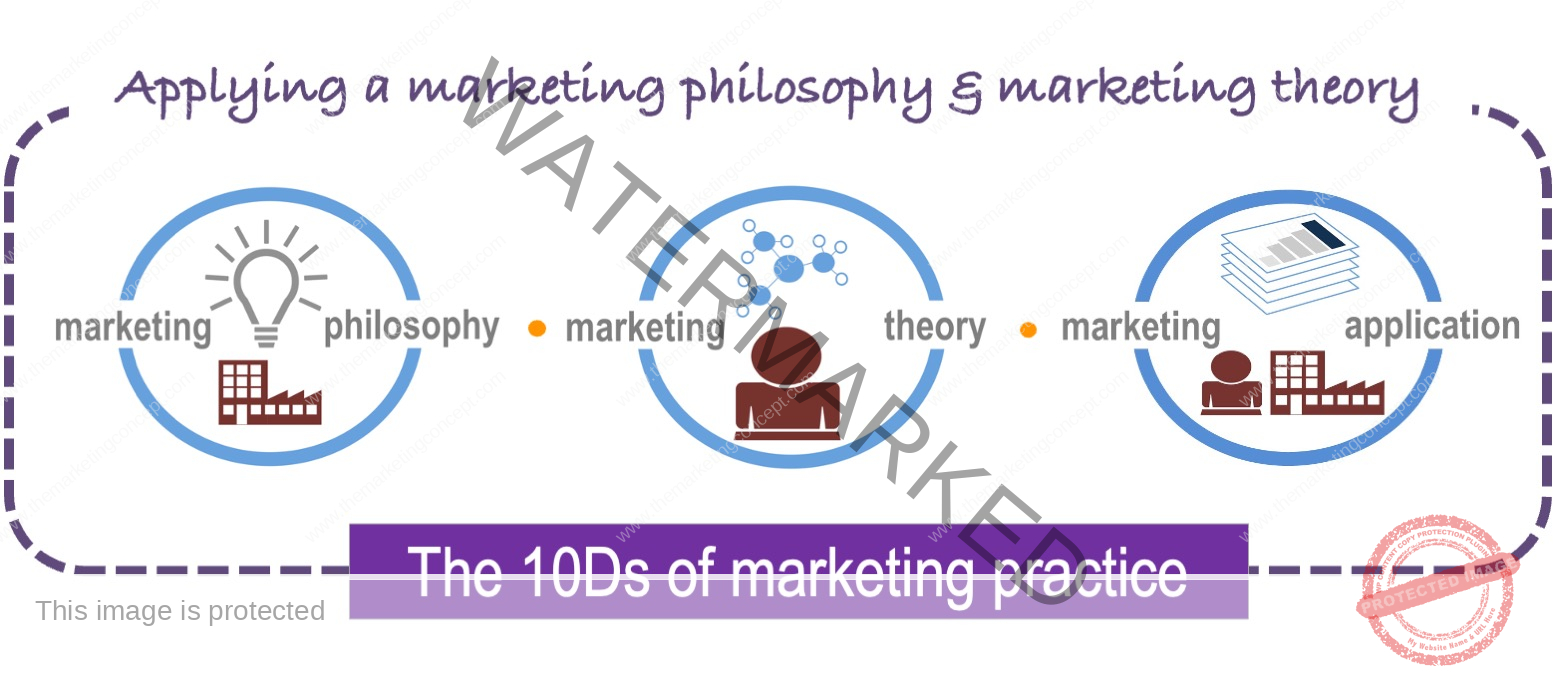
[7] Marketing is an applied process that is built on a carefully crafted marketing philosophy & sound theory
Putting the marketing concept into practice
The 10 Ds of best satisfying is one of the most important marketing statements you will ever read. To be best satisfying, organisations must understand the dreams and demands of their customers; design and develop products that are distinct, discernible, and desirable; deliver on promises, act in a dignified manner and provide long-term dividends to customers, the organisation, channel partners, and society.
As marketing practitioners, we should be mindful that consumers search rigorously for the best product quality and the best exchange value; therefore, markets are competitive and dynamic and maintaining market share is an ongoing challenge for organisations. This search by customers for quality, value, & best satisfying products requires an organisation to continually improve their product offering – this is often referred to as product & market vigilance.
Keep in mind – should a product and/or brand be perceived as less than best satisfying, then the product/brand will be mentally dropped from the customer’s considered set – AND word of mouth recommendations will cease – regardless of the organisation’s historical performance.
Customer value rings the cash register.
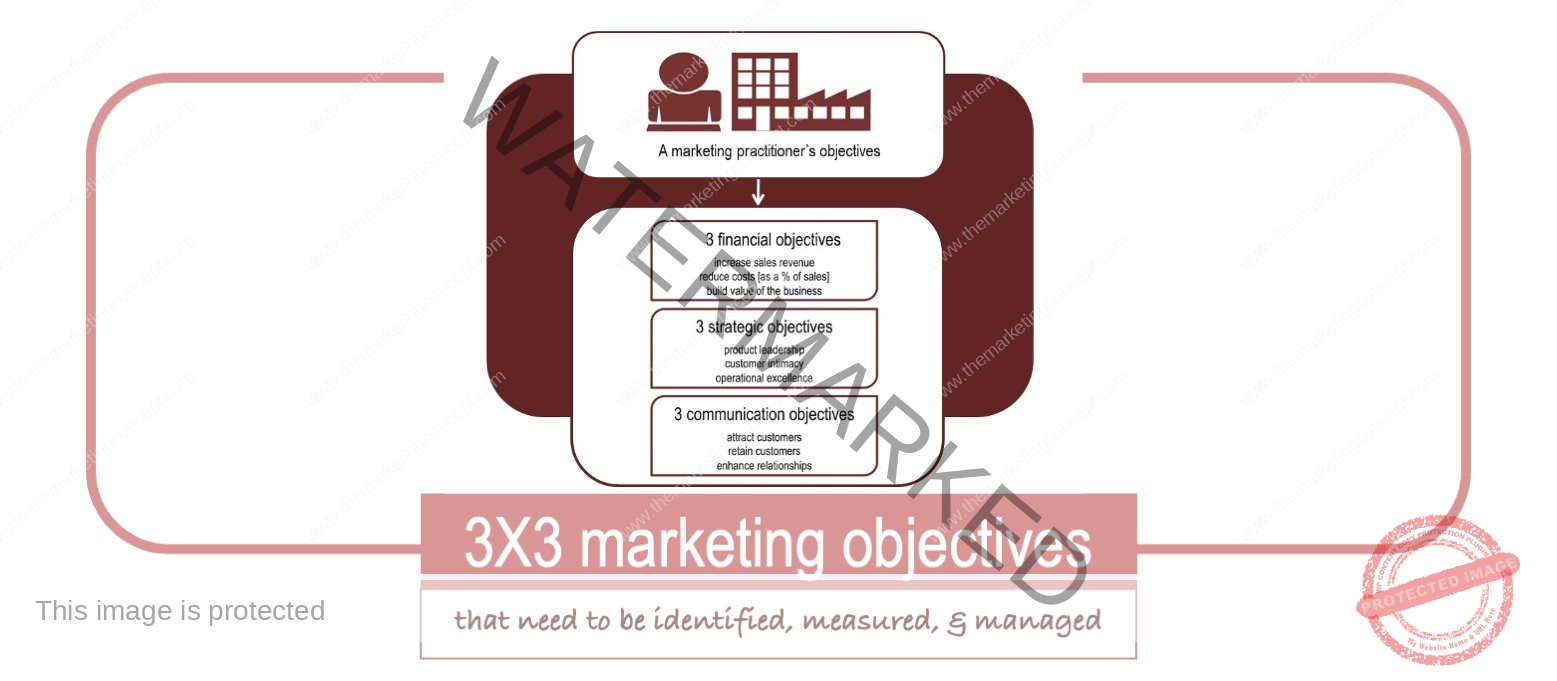
[8] Clear articulation of marketing [financial, strategic, & communication] objectives is essential
marketing objectives are central to all decisions
Organisations will articulate their strategic objectives and tactical objectives to manage the characteristics of their customers, organisation, market, and product. Nevertheless an analysis of organisational marketing objectives reveals 9 typical/common marketing objectives that fall into one of 3 groupings. The 3×3 objectives of marketing practitioners are broad, general, holistic and organisations would articulate their marketing objectives in quantitative and qualitative terms in the strategic business plan, the strategic marketing plan, and the tactical marketing action plans.
The 3 financial marketing objectives: Increase sales revenue; Reduce organisational costs [as a % of sales]; Build the value of the business
The 3 strategic marketing objectives: Product leadership; Customer intimacy; Operational excellence
The 3 communication marketing objectives: Attracting customers; Retaining existing customers; Enhancing relationships with existing customers
In a business plan or marketing plan the marketing objectives are articulated holistically, whereas, the marketing objectives are articulated in greater detail in the various marketing action plans. The marketing action plans would specify what needs to be measured and managed [+by whom] on a day to day basis at each strategic business unit or key tactical task.
Most organisations would identify, measure, and manage the appropriate marketing metrics/analytics to meet the marketing and organisational objectives.
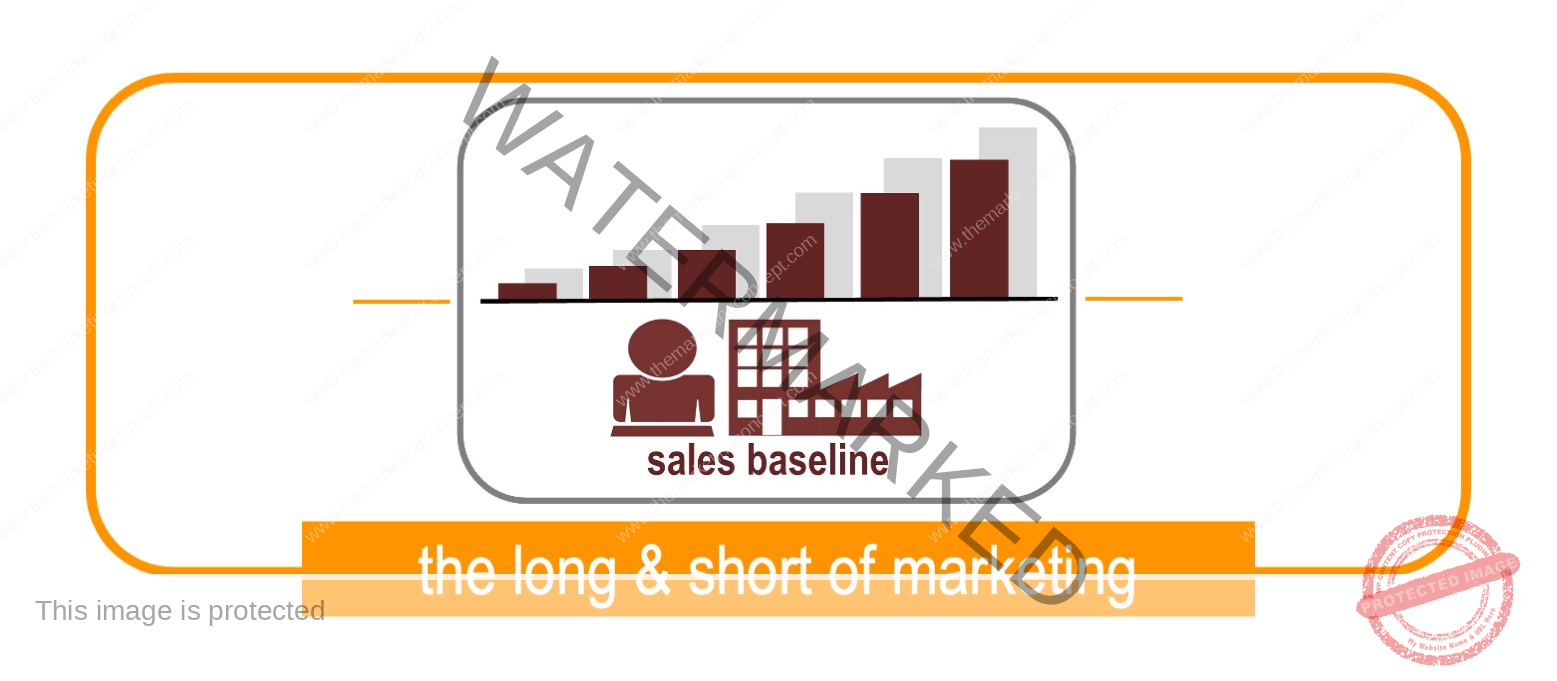
[9] Increase sales revenue & increase margins
Strange as is may seem an objective of marketing is to reduce dependence on advertising, sales promotions, & discounting
building business value through long-term strategies & short-term tactics
Given the importance of customer satisfaction, marketing practice is a mix of long-term strategies and short-term tactics working to achieve organisational marketing objectives [see 9 objectives of marketing practitioners]. Furthermore, we put forward the view that if an organisation measures, manages, and improves collective customer satisfaction [the satisfaction score of all customers] – then the sales baseline will rise over time. The sales baseline is the sales volume/revenue achieved regardless of any other sales enhancing tactics.
the long & short of marketing.
Building the sales baseline could also be referred to as building brand equity – a longitudinal representation of the unique product value proposition of an organisation’s product[s] in the mind of consumers. The sales baseline approach highlights that both long and short-term activities should be measured and managed. Building the sales baseline is long-term – the basic premise is that organisations will be less ‘dependent’ on short-term tactics [e.g., discounting the price, selling and sales promotions], therefore, in the longer-term organisations are able to achieve a competitive advantage by [a] increasing revenue, [b] reducing costs as a % of sales, and [c] increasing the value of the business. In the real world there will always be variations in demand and short-term sales revenue will need to be managed, however, the sales baseline approach highlights the need for short-term sales tactics to be considered and be congruent with long-term sales strategies.
Beware of ‘sugar fix sales tactics’ that do long-term damage to the health of a brand
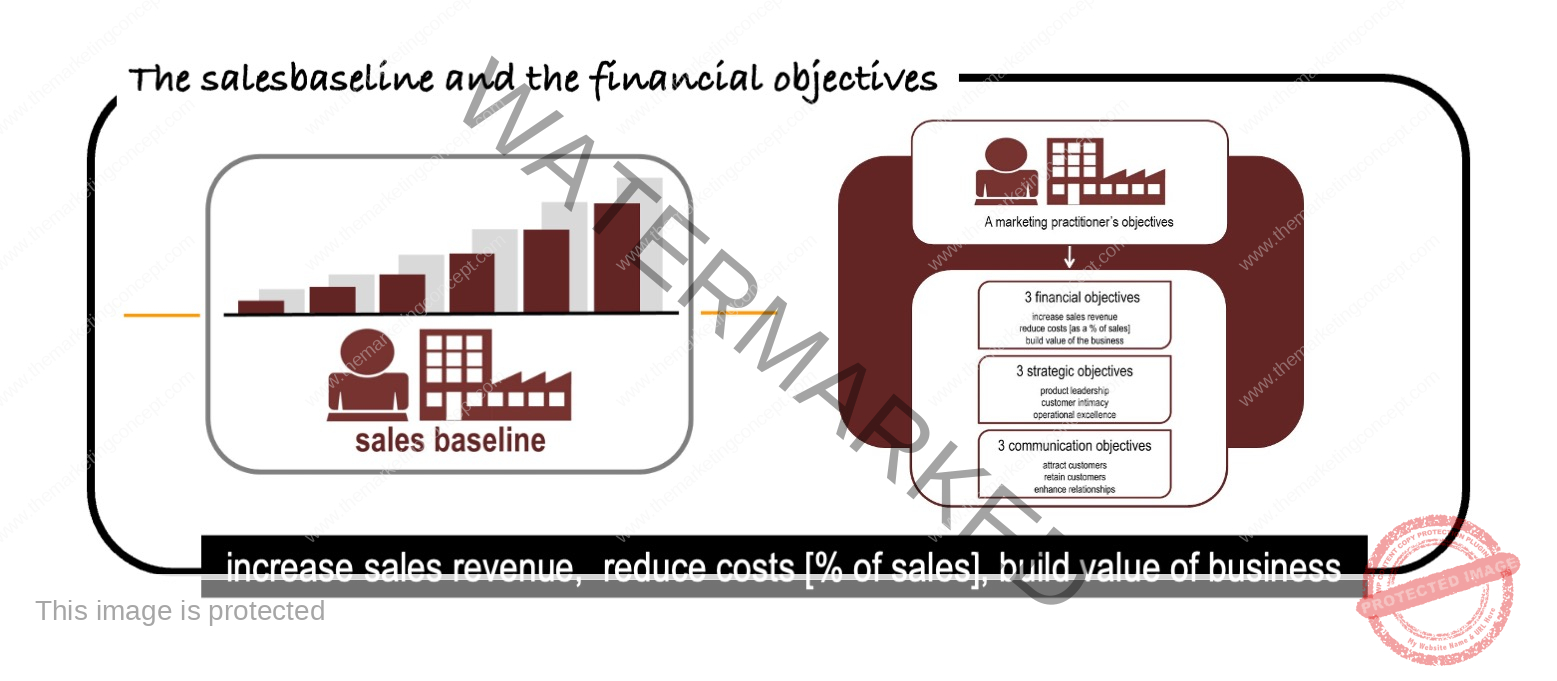
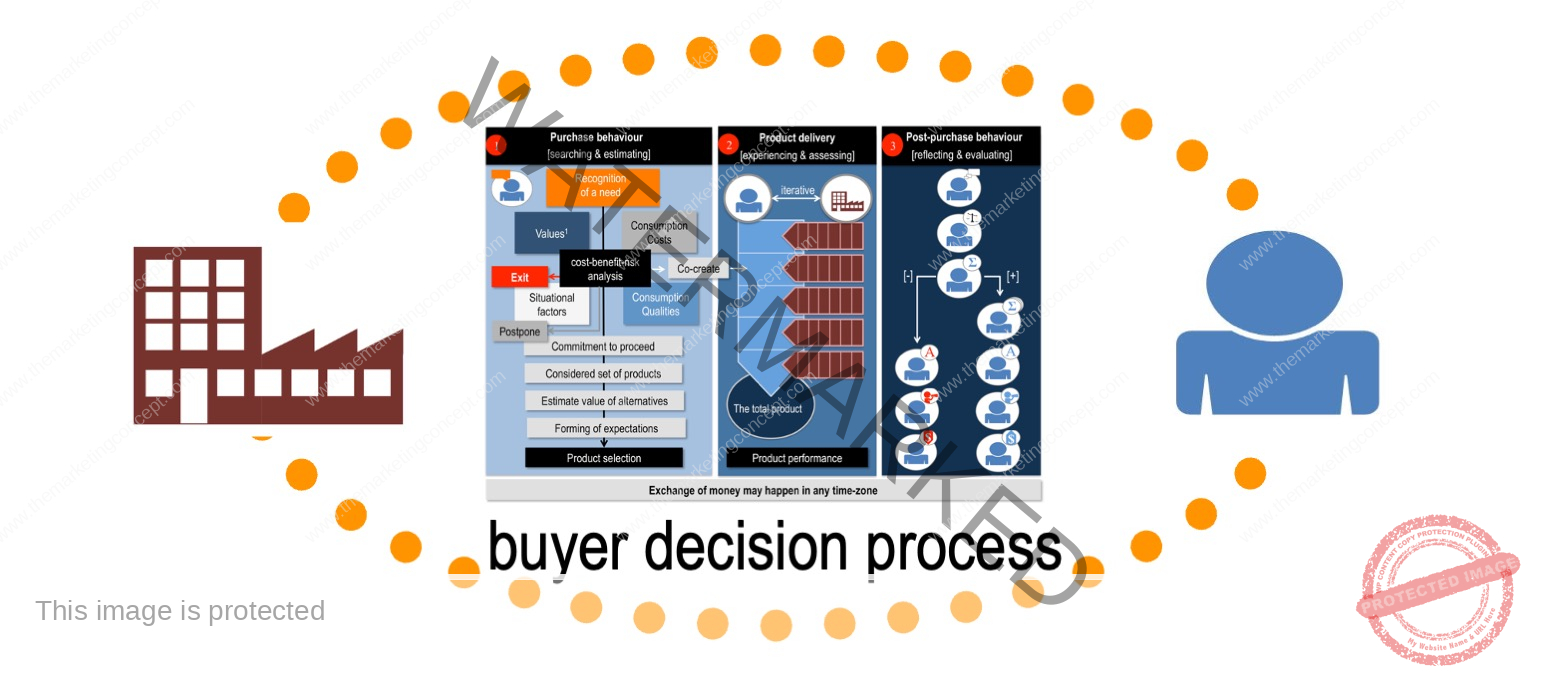
[10] Managing the buyer decision process is critical for survival & success
the buyer decision process – the consumer/customer’s journey through 3 time-zones
People, as consumers, learn and develop schemas from their experiences and observing others. A schema is the result of an innate cognitive process where people attend, interpret, organise, and catagorise information, consider the associations and relationships and store this information in an associative network for efficient retrieval, future conversations, and decision-making. A key task for organisations is to be mindful of consumer schemas and guide consumers comfortably through the buyer decision process.
The buyer decision process has 3 distinct time-zones – when:
- Searching for & selecting products
- Experiencing & assessing the product delivery
- When reflecting & evaluating what was expected against what was received
The buyer decision process is a process where consumers become customers. This transformation occurs when a consumer enters the buyer decision process as a suspect > then a prospect > to become a customer. The marketing objective is then to advance the first-time customer > repeat customer > member customer > advocate or evangelist for a product or organisation.
Although each step in the buyer decision process will be structurally similar for all products, the process will vary according to situational factors and the degree of consumer/customer involvement with the product; for example, there are clearly differences between searching and selecting a snack bar and searching and selecting a motor car.
Understanding the buyer decision process is critical for anyone involved in business
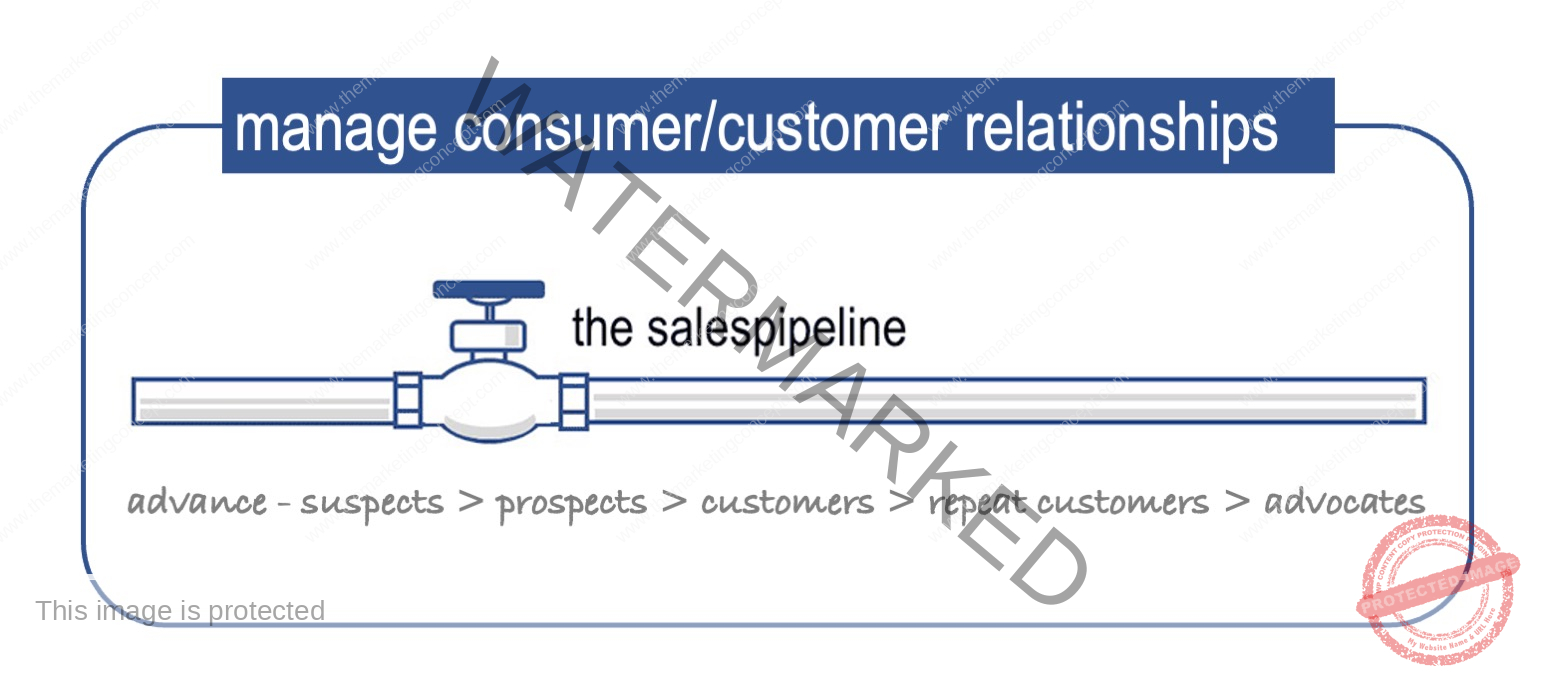
[11] A relational approach to increase revenue, reduce costs, build business value
Populating the salespipeline involves advancing consumers from suspects, to prospects, to first time customers, to repeat customers, to brand advocates
the buyer decision process, the sales baseline, & the salespipeline are all related
When crafting strategies and tactics marketing practitioners must consider both the individual and the collective consumer/customer.
For example; whilst it is easy to think of one customer’s journey from suspect to prospect to customer to repeat customer to advocate – organisations must manage multiple customers as they progress through the buyer decision process – keeping in mind that there are different stages and customers advance at different speeds – a process is required.
Organisations exist to satisfy a need at a societal and individual level – achieving outcomes and measuring progress is important. The salespipeline and the buyer decision process are related, and whilst the buyer decision process is more focussed on one consumer/customer’s journey managing the salespipeline helps a marketing practitioner to monitor and manage all customers and forecast likely sales [cashflow] and stock. Clearly, the managing the salespipeline and the sales baseline are related and the objective is to increase sales revenue whilst reducing the cost of sales as a percentage – a key component is positive word of mouth through customer satisfaction. Customer relationship management software [CRM] can assist organisations to manage the salespipeline and the sales baseline.
keep in mind – managing the salespipeline reduces the dependence on discounting
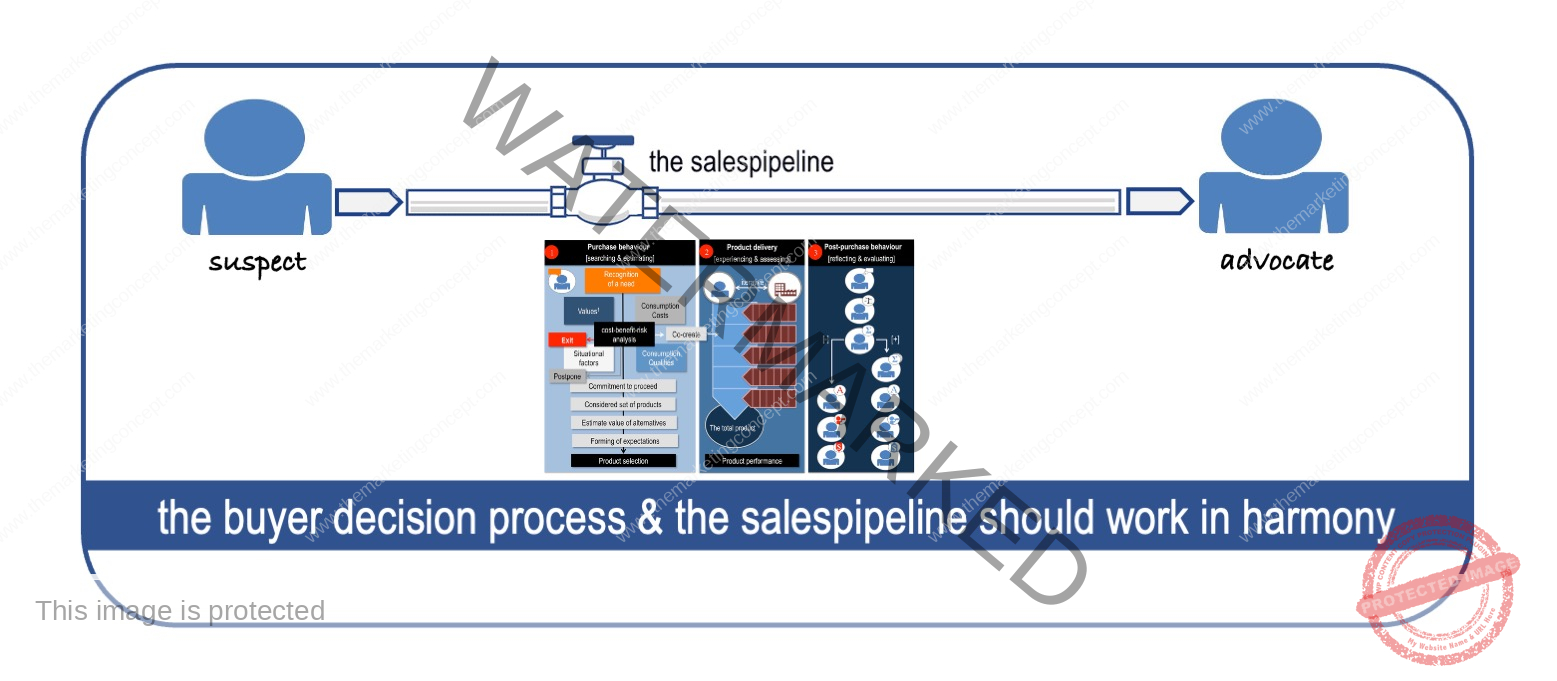
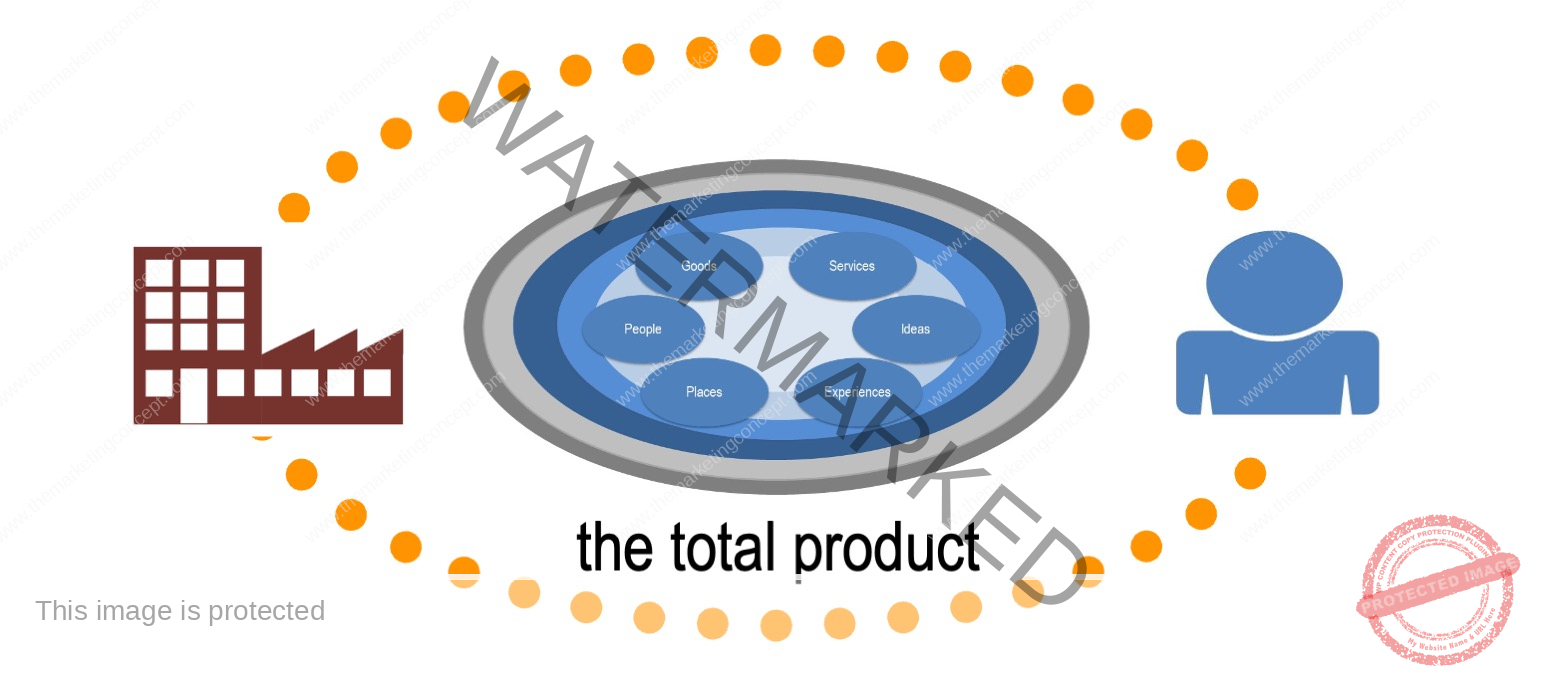
[12] best satisfying means designing, developing, & delivering a total product
the total product is the totality of what the customer receives in an exchange
The total product is the totality of what an organisation delivers to the customer – what is promised, therefore, what is expected, what is delivered, and what are the total costs to the customer. The total product is the totality of what is offered in an exchange [one exchange] between an organisation and a customer. To better serve customers marketing practitioners generally break down the total product into:
- Product considerations – the nature of the product, what a consumer and a marketing practitioner take into consideration when buying or designing and developing a product
- Product layers – holistically how a product is designed – what is core, what is expected, and how a product is augmented to distinguish it from competitors
- Product components – the 6 elements or qualities that constitute a product; the product components are goods, services, ideas, experiences, people, and places. Marketing practitioners employ the product components to create a product that is distinct, distinguishable, and desirable – a unique product value proposition.
The total product is critical – it is the basis for organisational success or failure. Furthermore, an organisation’s products are continually monitored by an organisation’s competitors and, therefore, the total product is a motivator for marketplace competition. Marketing practitioners who cannot produce a total product with a unique product value proposition are often subjected to a cycle of discounting and higher cost of sales.
the total product is the basis for organisational success or failure
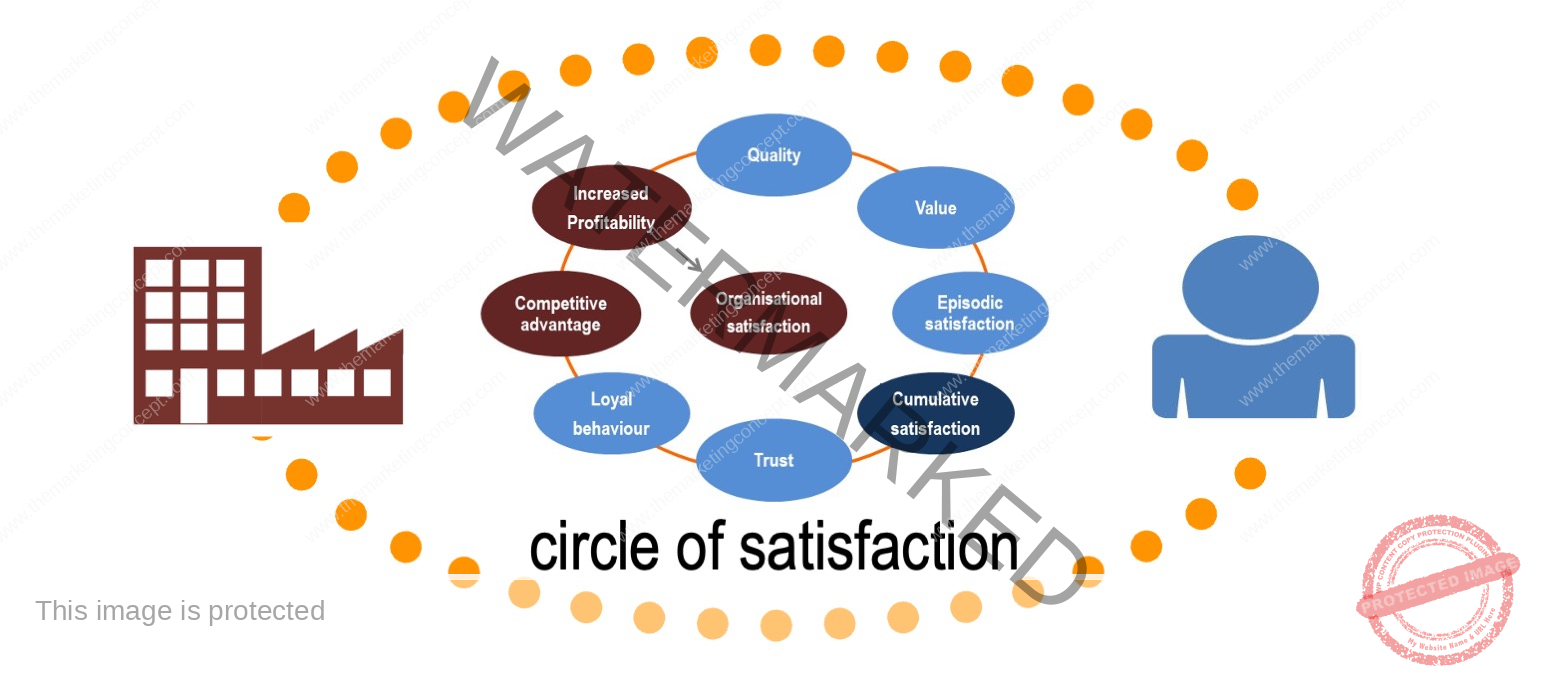
[13] Understanding quality, value, satisfaction, & expectations
looking at satisfaction through a different lens
When a consumers recognises an unmet need and there is intensity and motivation to enter the buyer decision process – they do so with the intent of receiving the best quality and value available. After searching and considering alternatives they select what they perceive to be the best product after considering their personal situational factors. Therefore, they enter an exchange with positive expectations of quality, value and satisfaction. Quality is the sum of the qualities/elements received in an exchange. Value is the qualities received compared to the costs outlayed. Costs include money, time, and effort. Satisfaction is a post-purchase evaluation of qualities received and costs outlayed compared with pre-purchase promises and expectations.
no one would enter an exchange if they expected to be dissatisfied
100% of customers enter the buyer decision process expecting satisfaction
Therefore, understanding customer expectations, delivering quality, and ensuring value are critical to customer satisfaction. Most organisations would also enter an exchange with the intent of satisfying a customer. Therefore, any episode of dissatisfaction is not only a deviation from customer expectations but also organisational expectations.
Remember an objective of marketing is to be best satisfying for the seller and the buyer.
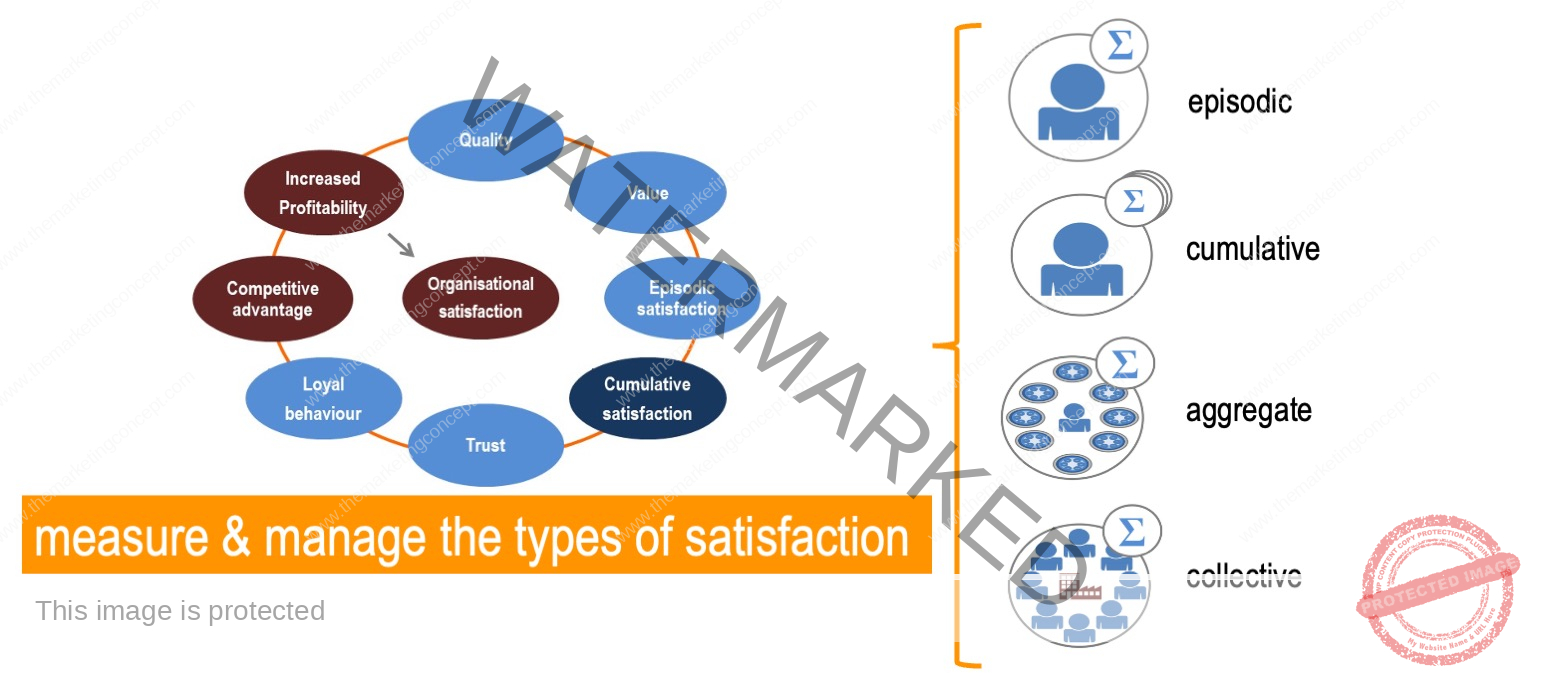
[14] best satisfying means measuring and managing – episodic, cumulative, aggregate, and collective satifaction
understanding the types of satisfaction is critical to brand management
The overall premise of the circle of satisfaction is that an organisation can only achieve a competitive advantage through a process that delivers quality, value, and customer satisfaction.
Whilst some products are only purchased once, there are other products that are purchased frequently or more than once. When a product is purchased more than once satisfaction takes on a different dimension. Firstly, there has to be an episode of satisfaction that motivates the customer to repurchase, then on each subsequent episode the product is reevaluated – this is referred to as cumulative satisfaction. Most organisations have more than one customer, delivering cumulative satisfaction to all customers is referred to as collective satisfaction. From a customer’s perspective [e.g., a holiday to Singapore, shopping at a mall] it is one product, however, the product is comprised of a number of products – these are referred to as aggregate products. This brings in a new type of satisfaction aggregate satisfaction – aggregate satisfaction can apply to one episode/transaction [e.g., a hiliday to Singapore] or multiple episodes/transactions [e.g., shopping at a mall] and measuring collective satisfaction with aggregate products is critical to ensure the objectives of the responsible organisation are met.
Cumulative customer satisfaction results in trust, and trust leads to loyal customer behaviour. Often people talk about ‘service’ as something an organisation performs for customers – this thinking misses one of the key objectives of marketing – that loyal customer behaviour is a ‘service’ – a service that increases revenue, lowers the cost of sales, and builds the value of the business – and delivers organisational satisfaction.
Whilst many understand the value of customer satisfaction to an organisation, less understand the types of customer satisfaction [1] episodic satisfaction, [2] cumulative satisfaction, [3] collective satisfaction, and [4] aggregate satisfaction and even less have processes in place to measure and cultivate each type of satisfaction.
The following is a brief description of the 4 types of customer satisfaction:
- Episodic satisfaction – one episode/transaction for one customer
- Cumulative satisfaction – multiple episodes for one customer
- Aggregate satisfaction – combination of multiple total products for one customer
- Collective satisfaction – multiple evaluations for all customers.
Some ask which type of satisfaction is the most important? Actually all types of satisfaction come together to form brand equity – the total value of the business, however, organisations only get one chance to make a good first impression, therefore start with episodic and build from there.
The most valuable service is the one that the customer performs for the organisation
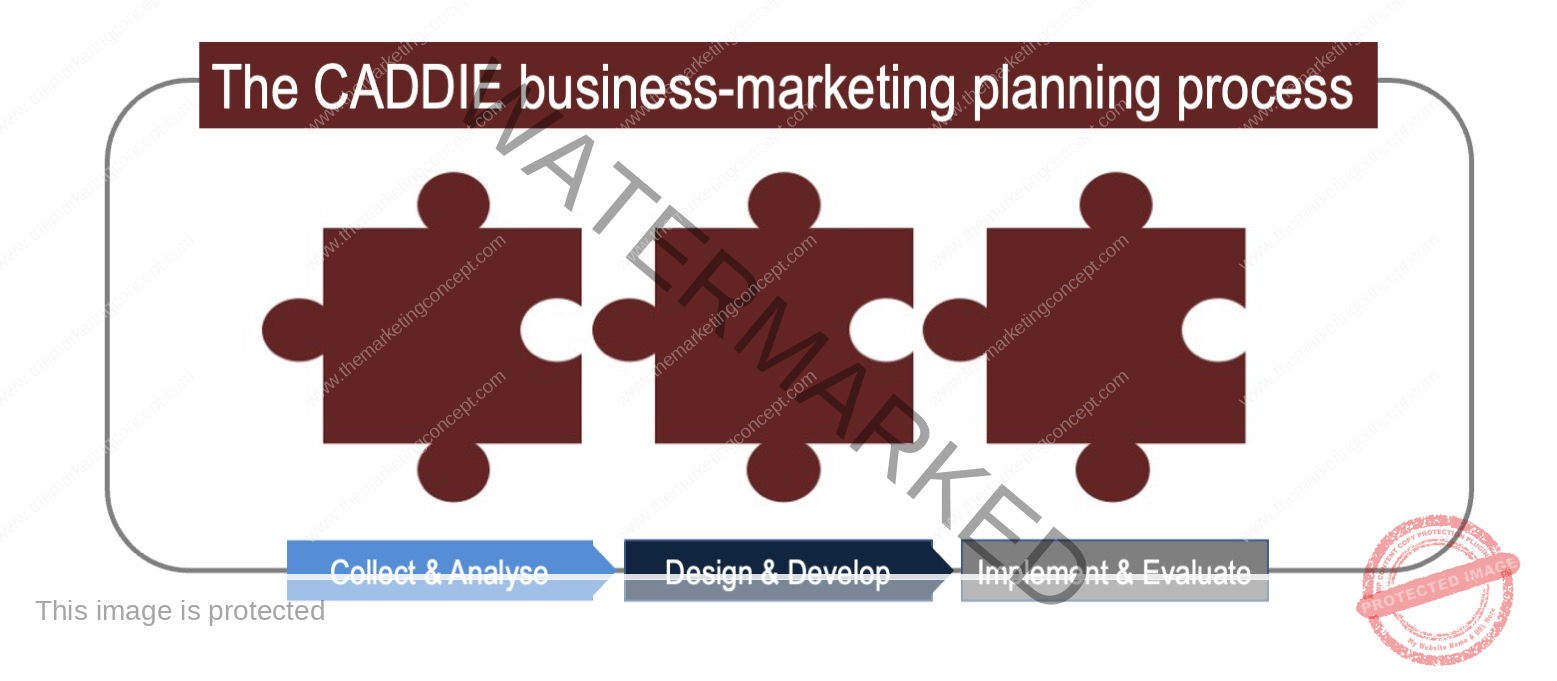
[15] a process to collect & analyse information; to design & develop a business plan, a marketing plan and then how to implement & evaluate the marketing action plans
CADDIE business-marketing planning process is a template to assists organisations to identify and achieve objectives
‘The CADDIE process: collect and analyse’ is about undertaking marketing research through a marketing audit. A marketing audit collects and analyses historical and current data [marketing metrics/analytics] on the customer, organisation, market, and products; the objectives are to assess the present performance and to assess the market attractiveness and ability to compete within each market segment. This marketing information is reported and presented to the Strategic Business Planning Group.
‘The CADDIE process: implement & evaluate’ each discipline will implement and evaluate their discipline action plans and take corrective action to ensure that the discipline works towards the overall organisational objectives. Although action plans will vary from organisation to organisation typical marketing action plans include – managing quality, internal and channel marketing, customer retention, external marketing communication, sales and salesforce management, software for marketing practitioners, the relational sales process.
Many think that creating a business plan is the key to a successful business, however, the CADDIE process highlight that marketing practitioners need information as constant evaluation and corrective action is needed to ensure the marketing objectives are achieved. This requires comparing the forecast performance outlined in the marketing action with the actual performance and designing and developing the appropriate actions. Although often neglected in marketing textbooks the evaluation and corrective action stage is a critical process.
WARNING: There is a tendency for non-marketing people to think of marketing as external communication. However, marketing is both a science and an art and there is a need to recognise the science of marketing, some suggest that amateur marketing practitioners are like amateur medical practitioners.
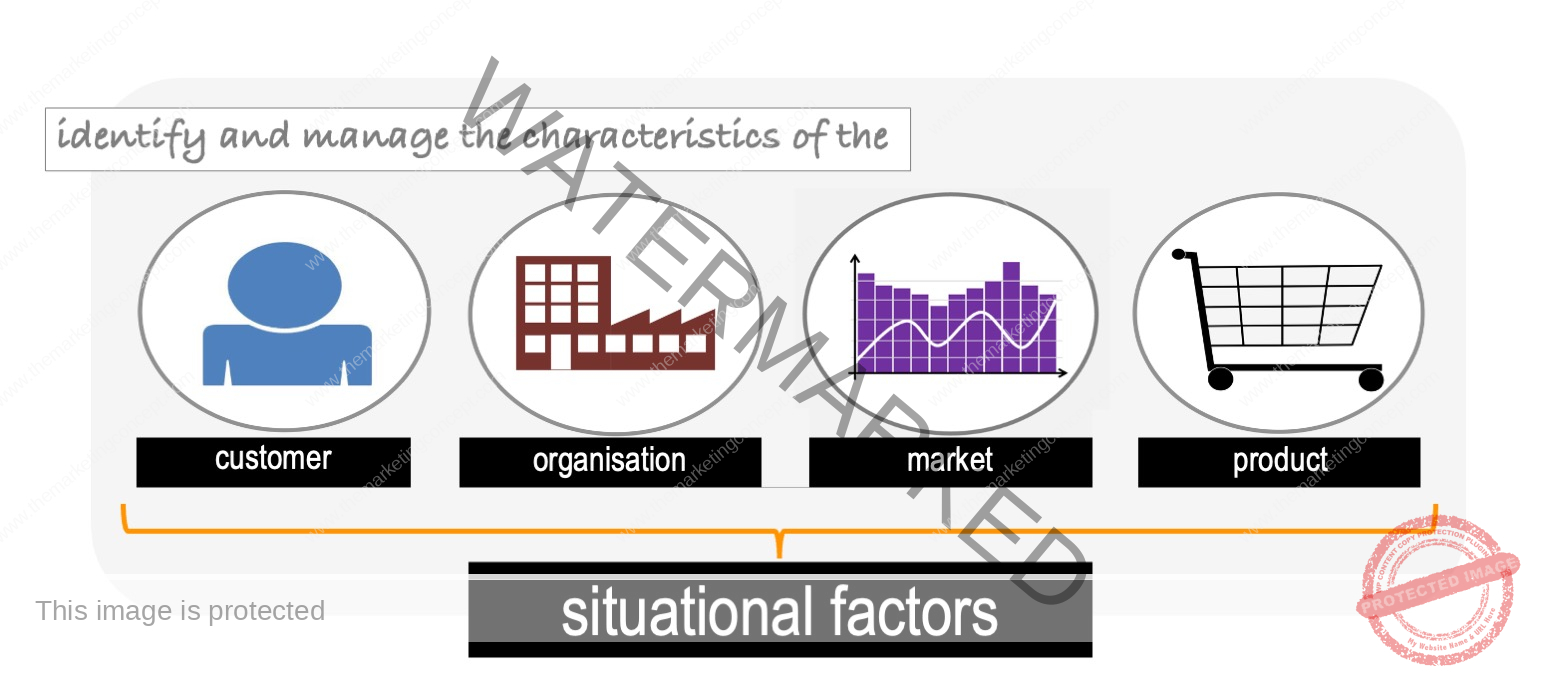
[16] measure & manage the situational factors [COMP factors – the customer, organisation, market, and product]
there are 4 categories of COMP factors – historic, current, forecasted & emergent
each has an important role in the CADDIE process
Reverse engineering a business
Often business people say
- ‘my business is unique’ – in many regards – all businesses are unique
- ‘my business is a small business’ – unfortunately there is a misconception that strategy is only for large business
- ‘I don’t do advertising all my work comes from referrals’ – that means your business is marketing at a higher level
- ‘we don’t have a product ours is a service business’ – there is a misconception that services are not products – they are and are part of every product
With these statements in mind it is clear that there is some confusion about what marketing is and is not. Furthermore, many small/medium businesses would benefit from a method/process/template for designing and developing marketing plans.
One of the key parts of a business/marketing plan is an audit of the prevailing situational factors that need to be managed. It is helpful to break the situational factors into the characteristics of the customer, organisation, market, and the product – also referred to as COMP factors. What makes the COMP factors interesting is that both consumers and marketing practitioners consider the COMP factors, however, they do so from different perspectives. Keep in mind that whilst a customer may purchase a product from time to time, organisations live or die on the success of their products.
Consumers/customers consider their own situational factors when entering the buyer decision process. Customers consider their personal characteristics their needs, willingness and ability to purchase, their priorities, customers also consider the relationship and reputation of the organisation, customers also considers the prevailing market characteristics and how market characteristics may impact their lives, customers also consider the characteristics of the product, the costs and benefits, and the degree of personal involvement with the considered product.
Marketing practitioners consider the situational factors of their organisation throughout the CADDIE business-marketing planning process. The CADDIE process begins with the collection & analysis of historic and current customer, organisation, market, and product [COMP] data. Next the CADDIE process involves forecasting the likely future customer, organisation, market, and product [COMP] data. With the COMP forecast the organisation designs the appropriate organisational objectives and then develop the appropriate business plan and the subsequent marketing plan [strategic] and marketing action plans [tactics]. Once the marketing action plans have been implemented the emergent COMP data is collected & analysed and evaluated and appropriate corrective action is taken.
The COMP factors from a marketing practitioner’s perspective
- [C] how consumers/customers have acted in the past, how they are likely to behave in the next planning cycle, & adapting to any changes as they unfold
- [O] the nature of the organisation – the philosophy, culture, performance, future strategic intentions and ability to meet objectives
- [M] the market conditions of the past, & present. The predicted future market conditions in which the organisation will operate & must adapt & respond
- [P] the nature of the products & organisational offerings – performance, degree to which the products satisfy consumer needs and wants – new product development
Marketing, from an organisational perspective, is an iterative process of working with historic, current, forecasted and emergent COMP data to meet the objectives articulated in the business plan, described in the marketing plan, and specified in the marketing action plans.
Perhaps revisit the 10 Ds towards best satisfying – To be best satisfying, organisations must understand the dreams and demands of their customers; design and develop products that are distinct, discernible, and desirable; deliver on promises, act in a dignified manner and provide long-term dividends to customers, the organisation, channel partners, and society.
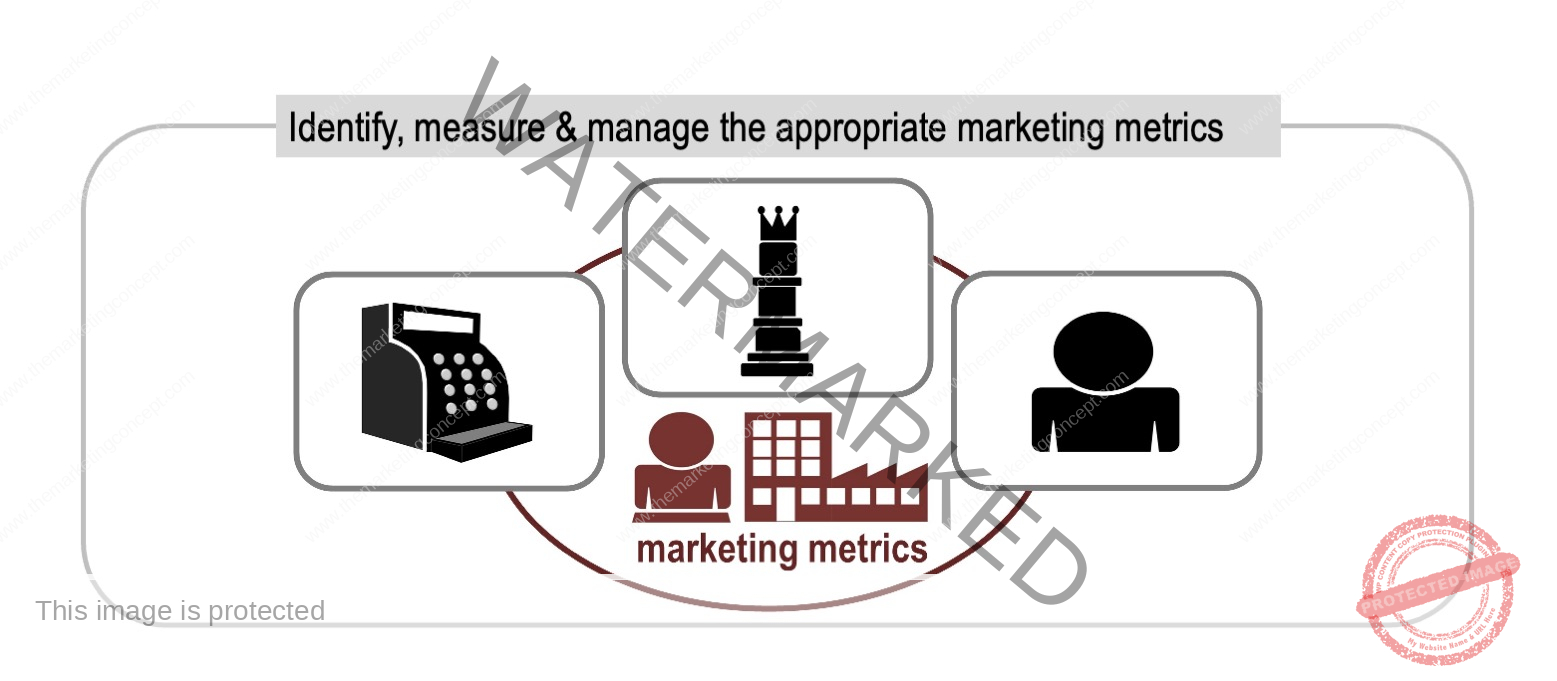
[17] It is important to recognise the influence of the situational factors, identify the unique COMP factors, however, it is critical to measure & manage the marketing metrics appropriate for each task
measure twice cut once
The objective is to make timely and better-informed decisions; decisions that may be long-term and strategic or short-term and tactical.
The importance of identifying and analysing appropriate marketing metrics in order to make informed decisions cannot be over emphasised. Furthermore, drilling-down and evaluating the effectiveness at a micro tactical level tactics is critical. Keep in mind that an organisation will only achieve the objectives of the strategic business plan and strategic marketing plan if it is evaluated at a micro level. For example, [1] sales performance may need to drilled down to identify branch and salesperson performance, whereas [2] people involved in social media will need a different set of marketing metrics/analytics.
Importantly, the COMP data that is collected and analysed in a marketing audit includes the collective data that was once collected to manage, measure and improve the day-to-day performance of the organisation [i.e., historic and current marketing metrics]. However, as the Strategic Business Planning Group requires a holistic perspective the marketing metrics data is reassembled/repurposed to reflect the historical and current performance of the organisation. Therefore, marketing metrics that were once micro and tactical in nature are collated into a macro and strategic format.
Accessing high quality and relevant information is particularly important in today’s dynamic marketplace/environment with short planning cycles, increased competition, higher consumer expectations, and increased public accountability [at all levels]. Given the increased importance of data, it is therefore critical that marketing practitioners clearly identify and articulate their requirements to ensure that their IT needs are delivered

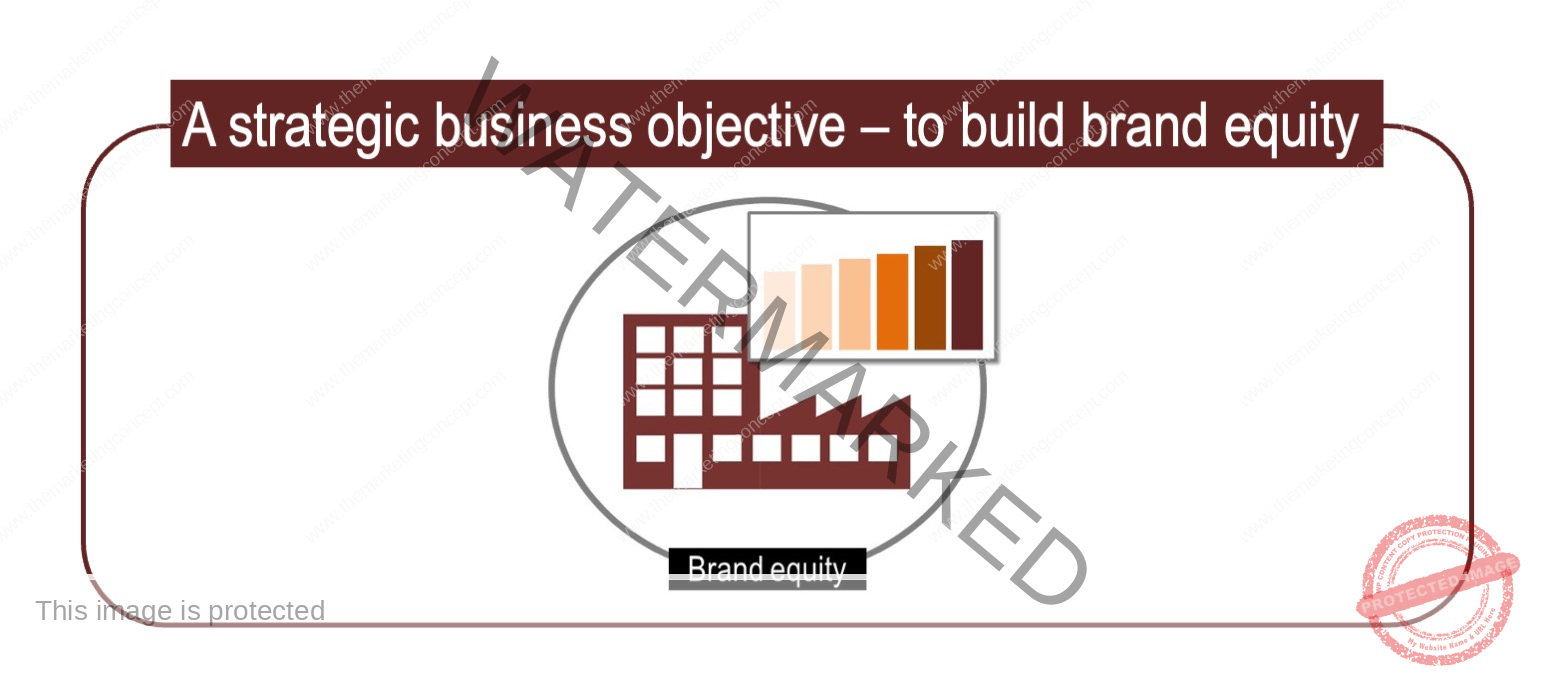
[18] A key objective is to build the value of the business – brand equity
Brand equity is the value of the future behaviour of all customers.
It is a non-material asset that is the result of everything an organisation promises & delivers.
Brand equity is a key measure of the value of an organisation.
brand equity is a quantitative measurement of past performance and likely future performance
Many talk about building brand equity as if it is something you do through an external communication campaign, they seem confused with brand awareness and recognition -sure they are important communication tactics. Some talk about it in qualitative terms, however, and it is the result of a strategic process. Although, brand equity is within the collective minds of the consumer and consumers think in terms of quality, value and satisfaction brand equity is a quantitative measurement of past performance and likely future performance.
Brand equity is built on a philosophy of best satisfying – best satisfying the customer and the organisation
To be best satisfying, organisations must understand the dreams and demands of their customers; designand develop products that are distinct, discernible, and desirable; deliver on promises, act in a dignified manner and provide long-term dividends to customers, the organisation, channel partners, and society.
a brand is a risk reducing strategy for both the consumer and the organisation
